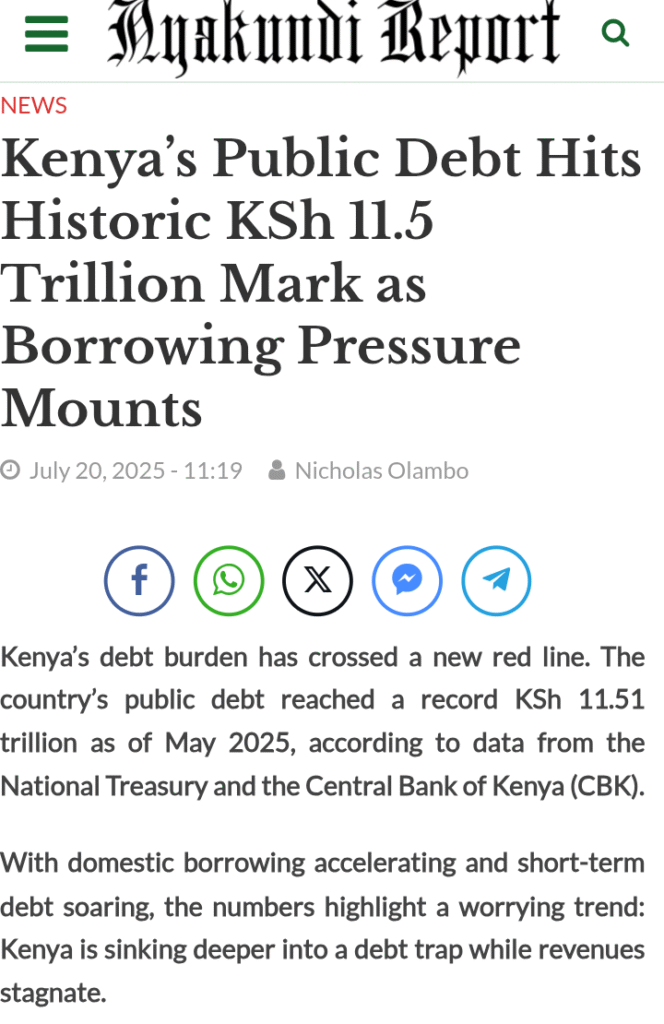Kenya’s debt burden has reached dangerous levels. As of May 2025, the country’s total public debt stood at a record KSh 11.51 trillion, according to data from the National Treasury and the Central Bank of Kenya.
This amount is worrying, especially because most of the borrowing is now happening within the country, and the rate is increasing quickly.
Revenues are not growing at the same pace, which means Kenya is taking more loans while collecting less money. Short-term borrowing, especially through Treasury Bills, is rising faster than long-term borrowing.
These short-term debts come with higher interest and must be repaid or renewed quickly. That puts more pressure on the government’s budget.
On top of this, the Kenyan shilling is losing value, making foreign debt more expensive to repay. Domestic borrowing now leads the way in Kenya’s debt growth. By July 2025, domestic debt was KSh 6.31 trillion, up from KSh 6.20 trillion just two months earlier. Treasury Bills alone hit KSh 1.036 trillion by early July.
This is the highest ever, and a clear sign that the government is depending heavily on short-term debt. These T-Bills now make up almost 17% of all domestic securities, up from just under 12% in 2024.
This shift means the government has to find money to repay debts more often, adding stress to an already tight budget. The government is also offering higher returns to attract investors, with recent T-Bill auctions showing rates as high as 9.73% for one-year loans.
Long-term Treasury Bonds also grew, reaching KSh 5.11 trillion by July 2025, up from KSh 4.63 trillion in June 2024. Even though they still make up over 83% of domestic debt, their share is falling due to the fast growth in T-Bills.
The Central Bank has been reopening older bonds to raise more funds. In June and July 2025, it reopened two bonds and raised over KSh 138 billion combined. These bonds offered high yields above 13%, showing that the government is still depending on institutional investors to meet its borrowing needs.
The Treasury plans to borrow KSh 635 billion from the local market in the current financial year.External borrowing is adding more trouble. Foreign debt reached USD 41.07 billion by May 2025, but due to the weaker shilling, the amount in Kenyan currency grew to KSh 5.31 trillion.

That’s a big jump from KSh 5.05 trillion in June 2024, even though the dollar amount only increased slightly. The cost of paying back these loans keeps rising, especially because the government must use more shillings to buy the same amount of dollars.
Some of this foreign debt comes with strict conditions and high interest, especially loans from commercial lenders and international institutions.
When Kenya earns fewer dollars from exports or tourism, repaying these loans becomes even harder.
One of the most serious effects of this debt is the huge amount the government is spending just to repay it. Between July 2024 and May 2025, Kenya spent KSh 1.448 trillion on debt payments, with more than KSh 1 trillion going to interest alone.
This means that a lot of the money that should go to development, salaries, and public services is now being used to pay debts.
The debt service-to-revenue ratio has climbed to almost 70%, more than double the safe limit set by the International Monetary Fund for developing countries.
Credit rating agencies are also cautious. Moody’s rates Kenya at Caa1 with a positive outlook, Fitch rates the country B− with a stable outlook, and S&P Global gives a similar rating.
These low scores reflect doubts about Kenya’s ability to handle its debt in a sustainable way. If things don’t change, Kenya risks falling into a full-blown debt crisis.
The country must act fast by changing its borrowing habits, improving how it collects taxes, and cutting unnecessary spending. If it fails to do so, Kenya’s economic future could be in serious danger.





















Add Comment